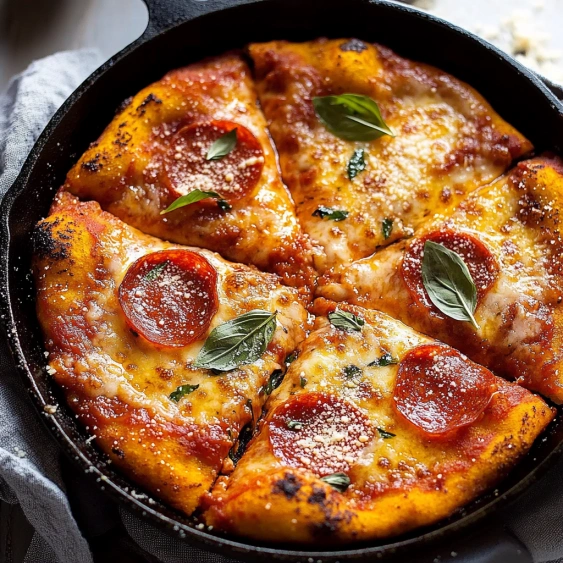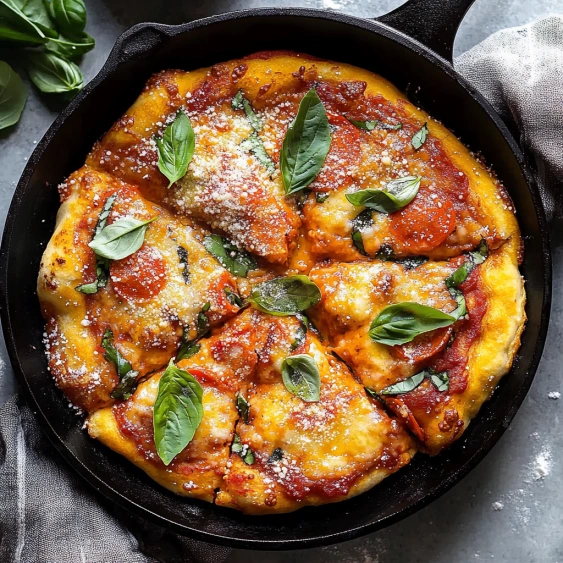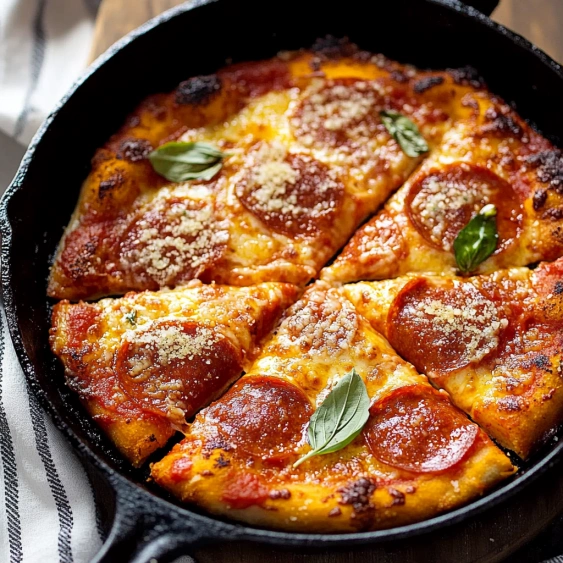 Pin it
Pin it
This homemade cast iron skillet pizza transforms your kitchen into an authentic pizzeria with minimal effort. The screaming hot cast iron creates that perfectly crispy crust with a chewy interior that rivals your favorite pizza joint, all without special equipment or techniques.
I discovered this method during pandemic lockdowns when pizza cravings hit hard but delivery wasn't an option. What started as a necessity became our Friday night tradition that my family now refuses to skip.
Ingredients
- Pizza dough: 1 lb store bought or homemade offers the perfect foundation and develops amazing texture in the hot skillet
- Olive oil: 2 tablespoons creates that crispy bottom crust and adds richness
- Pizza sauce: 1/4 cup just enough for flavor without making the crust soggy
- Dried thyme or oregano: 1 teaspoon these aromatic herbs infuse the sauce with classic Italian flavor
- Garlic powder: 1/4 teaspoon provides even garlic flavor throughout every bite
- Mozzarella cheese: 3/4 cup look for low moisture whole milk variety for best melting
- Kosher salt: finishing touch that elevates all the flavors
- Fresh basil leaves: adds bright color and aromatic finish
Step-by-Step Instructions
- Preheat the skillet:
- Place your 9 inch cast iron skillet inside a cold oven then crank the heat to 500 degrees. Let the skillet preheat with the oven which typically takes about 30 minutes. This crucial step ensures your crust gets that pizzeria style crispy bottom.
- Prepare the pan:
- CAREFULLY remove the screaming hot skillet using thick oven mitts and immediately add the olive oil. Swirl it around to coat the entire surface which creates a nonstick surface and helps develop the crust.
- Shape the dough:
- While the oven preheats work your dough on a lightly floured surface into a 9 inch circle. Use your fingertips to gently press the dough outward while maintaining a slightly thicker edge for the crust. The dough should be about 1/4 inch thick throughout.
- Transfer to skillet:
- Carefully transfer your dough circle to the hot oiled skillet. Work quickly but carefully as the skillet will be extremely hot. The dough will immediately start to bubble and cook on contact which is exactly what you want.
- Add sauce and seasonings:
- Spread the pizza sauce in a thin even layer leaving about half inch around the edges for the crust. Pierce the dough all over with a fork to prevent large bubbles from forming. Sprinkle the dried herbs and garlic powder evenly over the sauce to distribute the flavors.
- Add cheese and bake:
- Distribute the shredded mozzarella evenly over the surface then immediately transfer the skillet to the oven. Bake for 15-20 minutes watching for the cheese to melt completely and the crust edges to turn dark golden brown.
- Broil for color:
- For that authentic slightly charred top finish switch your oven to broil for the final 1-2 minutes. Keep a close eye on it as it can go from perfect to burnt very quickly.
- Garnish and serve:
- Remove from oven and immediately sprinkle with kosher salt while still hot. Add torn fresh basil leaves let cool for 2-3 minutes then slice and serve directly from the skillet.
 Pin it
Pin it
My absolute favorite part of this pizza is the contrast between the crispy bottom crust and the chewy interior. The first time I made this my husband declared it better than our local pizzeria which had been our gold standard for years. Now we save money and enjoy better pizza at home.
Troubleshooting Common Issues
If your pizza dough sticks to the pan you likely didn't use enough oil or the skillet wasn't hot enough before adding the dough. The sizzle when the dough hits the pan is your indicator that things are working correctly. For next time ensure your skillet is thoroughly heated and use slightly more oil.
The preheating process is nonnegotiable. Some home cooks try to skip this step to save time but the result is vastly inferior with a soggy undercooked bottom crust. The magic happens when that dough hits a surface that is already 500 degrees which immediately starts cooking the bottom.
If you notice your cheese browning too quickly before the crust is done try using a slightly lower oven rack position or drape a piece of foil loosely over the top for part of the cooking time. Remember you can always add more cheese during the last 5 minutes of baking.
Perfect Topping Combinations
The classic Margherita remains unbeatable on this style of pizza. Simply replace the dried herbs with fresh basil added after baking use fresh mozzarella torn into pieces instead of shredded and add a drizzle of quality olive oil after baking.
For meat lovers try adding thinly sliced pepperoni sausage crumbles or prosciutto. The high heat causes pepperoni to curl into crispy cups that hold tiny pools of flavor. Add these toppings before the cheese for optimal integration into the pizza.
Vegetables need special consideration when adding to skillet pizza. Watery vegetables like mushrooms bell peppers and onions benefit from a quick presauté to remove excess moisture. This prevents them from releasing water onto your pizza and creating soggy spots.
 Pin it
Pin it
Storage Tips
This pizza is best enjoyed fresh from the oven but leftovers can be stored in an airtight container in the refrigerator for up to 3 days. To reheat place slices back in a cast iron skillet over medium heat covered for 3-4 minutes which revitalizes the crust better than microwave reheating.
For make ahead preparation you can prepare your dough and toppings up to a day in advance. The preheated skillet method works best with room temperature dough so remove from refrigerator about 30 minutes before cooking if you've made it ahead.
Frequently Asked Questions
- → Why use a cast iron skillet for pizza?
Cast iron skillets retain and distribute heat extremely well, creating a pizza with a crispy, almost fried bottom crust similar to what you'd get from a brick oven. The preheating method mimics professional pizza ovens by providing immediate high heat to the dough when it's placed in the pan.
- → Can I use store-bought pizza dough?
Yes, store-bought pizza dough works perfectly for this method. The recipe calls for 1 lb of dough, which is the standard size sold at most grocery stores. Allow refrigerated dough to come to room temperature for about 30 minutes before stretching.
- → What toppings can I add to this pizza?
While this recipe features a simple cheese pizza, you can add any toppings you prefer. For meats and vegetables with high moisture content, consider pre-cooking them before adding to prevent a soggy crust. Classic options include pepperoni, mushrooms, bell peppers, or caramelized onions.
- → Why do you poke holes in the dough with a fork?
Poking holes in the dough with a fork (docking) prevents large air bubbles from forming during baking. This technique ensures the crust bakes evenly and maintains its shape, particularly important when using a hot skillet method.
- → How do I know when my pizza is done baking?
The pizza is done when the cheese is fully melted and the edges of the crust are dark golden brown, typically after 15-20 minutes at 500°F. The additional 1-2 minutes under the broiler is optional but creates those desirable golden brown spots on the cheese for enhanced flavor.
- → What size cast iron skillet works best?
This recipe specifies a 9-inch cast iron skillet, which creates a pizza with a thicker crust. If you use a larger skillet (10-12 inches), the crust will be thinner and may require less baking time. Adjust accordingly based on your preference for crust thickness.
